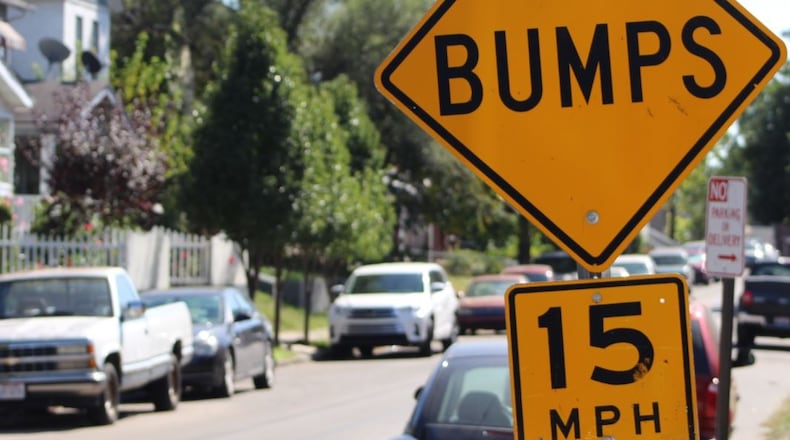Barrett and Mauro said speeding problems have gotten worse since their streets were repaved and they fear that lead-footed drivers eventually are going to cause a crash that hurts or kills someone if nothing is done.
“We need to stop these erratic drivers before they kill somebody,” Barrett said.
David Escobar, Dayton’s acting city engineer, said speed humps aren’t appropriate for Mauro’s street but he hasn’t ruled them out for Barrett’s.
Barrett lives on Meridian Street, which is a one-block street in the Burkhardt neighborhood.
Barrett recently submitted a petition to the city signed by herself and 17 neighbors that says they want two speed humps installed on Meridian Street.
The petition says there has been a “tremendous” increase in speeding on the street since it was repaved last month. Multiple East Dayton residents told this newspaper that speeding on their streets got worse after they were resurfaced because potholes and bumpy stretches of road forced drivers to hit the brakes.
Barrett said a city employee told her the city could not install humps on her street because it is about 50 feet too short.
Barrett recently attended a Dayton City Commission meeting where she asked city leaders to reconsider the petition and approve the requested speed humps.
Mauro also attended a Dayton City Commission meeting last month, as well as in March, where he urged the city to install speed bumps or humps on his street.
Mauro, who has lived on the 500 block of Burkhardt Avenue since 2007, said many motorists fly down his street at speeds well above the posted speed limits of 25 and 35 mph.
The 64-year-old said the speeding problems got worse after part of Burkhardt Avenue was resurfaced last year.
Mauro’s home is very close to a four-way intersection, and he said drivers regularly blow through the stop signs.
“During the summertime, on the weekends, three out of every 10 cars will not even hit the brakes and just go right through,” Mauro said.
This newspaper witnessed a couple of drivers fail to stop at the stop signs on a recent weekday afternoon.
Some passing vehicles also appeared to be traveling well above the 25 mph posted speed limits, and multiple cars stopped at the intersection but then floored it, accelerating as if they were racing on a drag strip.
Mauro told this newspaper he believes putting speed bumps at Burkhardt Avenue and Garland Avenue would be the best solution. But he said he’d support installing speed trailers if other options aren’t feasible.
Speed trailers snap photographs of the license plates of speeding vehicles, and police use that information to issue fines to owners.
The Dayton Police Department set up a radar speed sign on Burkhardt Avenue near Garland Avenue that was in operation from April 11 to May 2, said James Rider, a police information specialist for the police department.
The sign recorded the speeds of 31,612 vehicles going eastbound on Burkhardt Avenue, and only about 1,070 vehicles were traveling at 36 mph or faster, he said.
The speed limit for that area is 25 mph, Rider said, and nearly 80% of vehicles recorded were traveling 30 mph or less.
But Mauro said he watches cars drive by his home every day and it’s obvious that many are traveling at very fast and very dangerous speeds.
Mauro said he doesn’t know why the data police collected didn’t reflect that. He said maybe the radar wasn’t in a good position to catch speeding vehicles, and he agreed that the radar speed sign might have slowed drivers down.
Escobar, Dayton’s acting city engineer, said speed bumps are not suitable for Burkhardt Avenue because it is a thoroughfare that is excluded from receiving neighborhood traffic control devices.
Escobar said Burkhardt Avenue is heavily used by emergency responders, including crews working out of fire station 18.
He said speed bumps would slow response times. He also said the “watch your speed” sign police put up did not show an excessive number of speeding vehicles.
As for Meridian Street, Escobar said it is a little over 300 feet long and the city’s traffic services process states that speed humps should not be within 200 feet of a right-of-way traffic control sign.
Speed humps also are supposed to be 400 feet apart.
Still, Escobar said he wouldn’t rule out the possibility of Meridian Street getting speed humps, but the matter would require further investigation.
Dayton is home to about 469 speed humps and bumps, and the city installed four new ones last year.
Dayton residents can request speed humps on their streets or other traffic control devices by submitting a petition in support that contains the signatures of at least 51% of the households in the affected area.
The petitions also must be signed by the president of the neighborhood organization and the priority board chairperson.
After petitions are submitted and reviewed, the city sends out ballots to all affected households.
The city will install traffic control devices if three-fourths of affected households provide an affirmative response. It costs the city about $3,400 to install speed humps and $1,700 to install speed bumps.
About the Author


